七年级英语学案10
初一英语学案范例参考答案
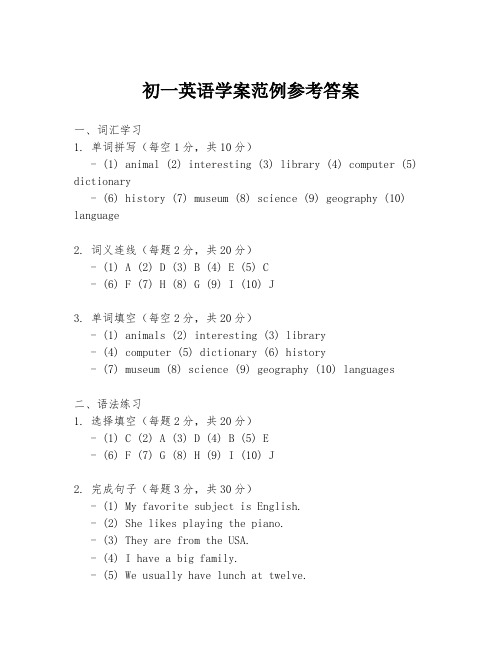
初一英语学案范例参考答案一、词汇学习1. 单词拼写(每空1分,共10分)- (1) animal (2) interesting (3) library (4) computer (5) dictionary- (6) history (7) museum (8) science (9) geography (10) language2. 词义连线(每题2分,共20分)- (1) A (2) D (3) B (4) E (5) C- (6) F (7) H (8) G (9) I (10) J3. 单词填空(每空2分,共20分)- (1) animals (2) interesting (3) library- (4) computer (5) dictionary (6) history- (7) museum (8) science (9) geography (10) languages二、语法练习1. 选择填空(每题2分,共20分)- (1) C (2) A (3) D (4) B (5) E- (6) F (7) G (8) H (9) I (10) J2. 完成句子(每题3分,共30分)- (1) My favorite subject is English.- (2) She likes playing the piano.- (3) They are from the USA.- (4) I have a big family.- (5) We usually have lunch at twelve.- (6) He can speak three languages.- (7) They are going to the park this weekend.- (8) She has a lot of books.- (9) I don't like math because it's too difficult.- (10) We are going to visit the museum tomorrow.三、阅读理解1. 判断正误(每题2分,共10分)- (1) T (2) F (3) T (4) F (5) T2. 信息匹配(每题3分,共15分)- (1) B (2) D (3) A (4) C (5) E3. 简答题(每题5分,共20分)- (1) The boy's name is Tom.- (2) They are going to the library to read books.- (3) She wants to be a teacher because she likes children. - (4) He thinks English is interesting and useful.四、写作练习1. 根据提示写一篇小短文(30分)- 假设你是一名初一学生,名叫李华。
人教版七年级英语全册导学案
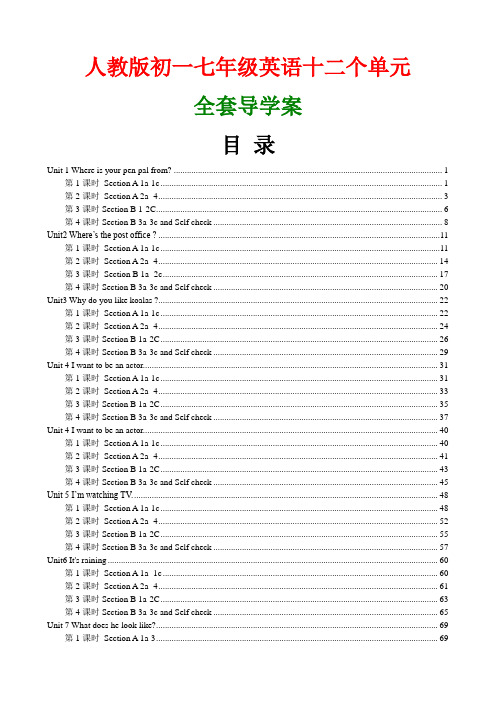
人教版初一七年级英语十二个单元全套导学案目录Unit 1 Where is your pen pal from? (1)第1课时Section A 1a-1c (1)第2课时Section A 2a -4 (3)第3课时Section B 1-2C (6)第4课时Section B 3a-3c and Self check (8)Unit2 Where’s the post office ? (11)第1课时Section A 1a-1c (11)第2课时Section A 2a -4 (14)第3课时Section B 1a -2c (17)第4课时Section B 3a-3c and Self check (20)Unit3 Why do you like koalas ? (22)第1课时Section A 1a-1c (22)第2课时Section A 2a -4 (24)第3课时Section B 1a-2C (26)第4课时Section B 3a-3c and Self check (29)Unit 4 I want to be an actor. (31)第1课时Section A 1a-1c (31)第2课时Section A 2a -4 (33)第3课时Section B 1a-2C (35)第4课时Section B 3a-3c and Self check (37)Unit 4 I want to be an actor. (40)第1课时Section A 1a-1c (40)第2课时Section A 2a -4 (41)第3课时Section B 1a-2C (43)第4课时Section B 3a-3c and Self check (45)Unit 5 I’m watching TV (48)第1课时Section A 1a-1c (48)第2课时Section A 2a -4 (52)第3课时Section B 1a-2C (55)第4课时Section B 3a-3c and Self check (57)Unit6 It's raining (60)第1课时Section A 1a -1c (60)第2课时Section A 2a -4 (61)第3课时Section B 1a-2C (63)第4课时Section B 3a-3c and Self check (65)Unit 7 What does he look like? (69)第1课时Section A 1a-3 (69)第2课时Section A 3a -4 (72)第3课时Section B 1a-2C (76)第4课时Section B 3a-3c and Self check (78)Unit 8 I’d like some noodles (83)第1课时Section A 1a-1c (83)第2课时Sectiona A 2a-4 (85)第3课时Section B 1a-2c (88)第4课时Section B 3a-4 and Self check (92)Unit9 How was your weekends? (97)第1课时Section A 1a-1c (97)第2课时Section A 2a -4 (99)第3课时Section B 1a-2C and Shelf check-3 (102)第4课时Section B 3a-3c (105)Unit 10 Where did you go on vacation? (109)第1课时Section A 1a-1c (109)第2课时Section A 3a -4 (112)第3课时Section B 1a-2C (113)第4课时Section B 3a-3c and Self check (116)Unit 11 What do you think of game shows? (119)第1课时Section A 1a-2c (119)第2课时Section A 3a -4 (123)第3课时Section B 1a-2C (125)第4课时Section B 3a-3c and Self check (128)Unit 12 Don't eat in class. (133)第1课时Section A 1a-1c (133)第2课时Section A 2a -4 (135)第3课时Section B 1a-2C (140)第4课时Section B 3a-3c and Self check (141)七年级英语下册第一单元学案Unit 1 Where is your pen pal from?第1课时Section A 1a-1c【学习目标】1. 掌握P 1 单词2.掌握句型:—Where is your pen pal from? —He is from Australia.3.掌握世界上一些国家的英文名称及地理位置。
人教版七年级英语下册教案 Unit 10 单元导学

Unit10 I'dlikesomenoodles.
1.本单元话题以“食物”展开,情境属于新课标“人与社会”主题范畴中的“历史、社会与文化”这一主题群,涉及子主题“跨文化沟通与交流,语言与文化”。
2.单元主题体现《中国学生发展核心素养》中的“文化基础”方面,提升学生的“人文底蕴”这一素养,立足于“人文情怀”这一基本要点。
3.能识记有关食品的词汇;能正确识别可数名词与不可数名词;能熟练运用“Whatkindofnoodlesdoyouhave ?”“Whatsizewouldyoulike?”等句子询问他人对食物的要求。
4.通过听听力材料,获取与食物相关的信息。
5.能运用wouldlike 进行写作。
6.在交流中学会热情好客,礼貌地表达自己的需要。
续表
【课时建议】本单元建议5课时
SectionA(1a-1c)(一课时)
SectionA(2a-2d)(一课时)
SectionA(GrammarFocus-3c)(一课时)
SectionB(1a-1d)(一课时)
SectionB(2a-SelfCheck)(一课时)
词汇短语:主要采用图片及多媒体展示助记忆法。
基本句子:采用多媒体展示及交际法(利用多媒体展示两人进行交际时的情景)。
语法:学会如何点餐。
七年级英语上册m10教案

外研版七年级英语上册M10的教案
一、教学目标
知识目标:掌握与春节相关的词汇和表达方式,如“贴春联”、“包饺子”、“放鞭炮”等。
能力目标:能够运用所学知识进行简单的口头和书面表达,介绍春节的传统习俗和文化内涵。
情感目标:培养学生对中国传统节日的热爱和自豪感,增强文化自信。
二、教学内容
词汇:春节、春联、饺子、鞭炮等与春节相关的词汇。
句型:介绍春节的传统习俗和文化内涵的句型,如“春节是中国最重要的传统节日,人们会贴春联、包饺子、放鞭炮等”。
阅读:一篇介绍春节的文章,让学生了解更多关于春节的知识。
写作:写一篇关于春节的短文,介绍自己的春节经历或感受。
三、教学方法
实物展示:展示与春节相关的物品,如春联、饺子等,帮助学生更好地理解词汇。
情景模拟:模拟春节的场景,让学生扮演不同的角色,
进行对话练习,提高口语表达能力。
小组讨论:让学生分组讨论春节的传统习俗和文化内涵,培养合作意识和探究能力。
游戏互动:设计有趣的课堂游戏,让学生在轻松愉快的氛围中学习英语。
四、教学步骤
导入:通过提问导入新课,如“你们知道春节是什么时候吗?你们在春节期间有哪些传统习俗?”等。
新课呈现:通过实物展示、情景模拟、小组讨论等方式呈现新知识,让学生更好地理解词汇和句型。
巩固练习:设计多种形式的练习题,如填空、选择、翻译等,让学生巩固所学知识。
总结反馈:对本节课所学内容进行总结反馈,强调重点和难点,让学生更好地掌握所学知识。
作业布置:布置与本节课所学内容相关的作业,如写一篇关于春节的短文等。
七年级英语下册学案及答案教案

七年级下册学案Unit 1 Where’s your pen pal from?Section ATeacher’s words: Actions speak louder than words.知识目标:1. Words: Canada, France, Japan, the United States, Australia, Singapore, the United Kingdom,Sydney, New York, Pairs, Toronto, Tokyo, French, Japanese, pal, country, live, language, world, like, dislike.2. Phrases: talk about, be from/ come from, pen pal, speak English, a little与little 的区别,myfavorite subject, tell sb. about sth, like doing sth.3. Important sentences: 1) --- Where’s your pen p al from?2) --- Where does he live?3) --- What language does he speak?4) ---- What’s your favorite subject?预习检测:1.来自______________2.笔友______________3.做运动______________4.讲英语______________5.给某人写信______________6.住在______________7.一点法语______________ 8. 太难______________9.去看电影______________ 10.喜欢做某事______________情景导入:1. To show a photo of Sydney and talk about it.2. To ask the students some questions.自主探究:1. The students open the books, turn to Page 81 and read the first letter. After that, the students answer three simple questions.2. The students read after the tape and go on answering some more questions.Ⅳ、合作交流:1.The students read the letters that the teacher gives them and then choose one pen pal they like.2.Do a report.My partner’s nam e is _________. His new pen pal’s name is ________.He is _______ years old. He is from __________.He lives in ___________. At school, he likes ______________.His favorite ___________ is __________________.I think he can be my partner’s pen pal. Do you think so?拓展创新:Groupwork1.Discussion: In your group, do you like your pen pals? Who likes? Why? ( Tell some reasons )2.Report.In our group, ________of us lik e his pen pal. Because his pen pal …达标测试:一、首字母填空1. She l_______ in Bei Hai.2. What l _______does Maria speak?3. Where are your friend f_______?4. King’s f_______ movie is the Long Weekend.5. China is a great c_______ .6. Mr. Brown is from A_______.7. Can he speak J_______ ?8. Rush Hour is an action m _______ .9. It is an i_______ story.10. J_______ is the seventh month in the year.二、单选( )1. _______ do you come from?A. WhenB. HowC. WhereD. Why( )2.Sam likes_______ his friends.A. to playB. playsC. play withD. playing with( )3.She lives_______ Sydney.A. atB. onC. inD. behind( )4.Where_______ she ? ---In Australia.A. do; liveB. does; livesC. do; livesD. does; live( )5.Do you want_______ French?A. to learn B learns. C. learning D. learn三、完形填空:阅读下面短文,掌握其大意,然后从各题所给的四个选项中选出最佳答案,并将其标号填入括号内。
七年级下册英语终极学案

七年级下册英语终极学案
由于版权和地区教育差异等因素,我无法直接提供七年级下册英语“终极学案”的具体内容。
但我可以给你一些建议,帮助你更好地学习和准备英语课程:
1.理解课程目标:首先,你需要明确本学期英语课程的学习目标。
这通常包括词汇、语法、听说读写等各项技能的提升。
2.制定学习计划:制定一个实际可行的学习计划,包括每天的学习时间和内容。
坚持按计划学习,可以有效提高学习效率。
3.注重基础知识:英语学习中,基础知识非常重要。
确保你掌握了所有必要的词汇和语法规则,这有助于你更好地理解和使用英语。
4.大量练习:通过大量的听说读写练习,提高你的英语技能。
可以尝试阅读英文书籍、观看英文电影、听英文歌曲等方式,培养语感。
5.参与课堂活动:在课堂上积极参与讨论和活动,这不仅可以提高你的英语口语能力,还可以增强你的自信心。
6.及时复习:定期复习所学内容,巩固记忆。
你可以制定复习计划,定期回顾和测试自己的学习效果。
7.利用学习资源:利用各种学习资源,如词典、语法解析、在线课程等,帮助你更好地理解和掌握英语知识。
8.保持积极态度:保持积极的学习态度,遇到困难时不要轻易放弃。
相信自己的能力,坚持不懈地学习,你一定能够取得进步。
希望这些建议对你有所帮助。
如果你需要更具体的帮助,建议你向你的英语老师或同学寻求指导。
英语星期教案
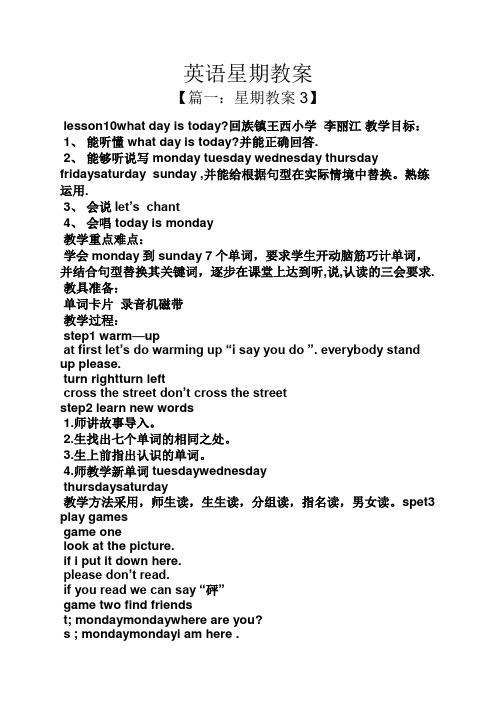
英语星期教案【篇一:星期教案3】lesson10what day is today?回族镇王西小学李丽江教学目标:1、能听懂 what day is today?并能正确回答.2、能够听说写 monday tuesday wednesday thursday fridaysaturday sunday ,并能给根据句型在实际情境中替换。
熟练运用.3、会说let’s chant4、会唱 today is monday教学重点难点:学会monday到sunday 7个单词,要求学生开动脑筋巧计单词,并结合句型替换其关键词,逐步在课堂上达到听,说,认读的三会要求.教具准备:单词卡片录音机磁带教学过程:step1 warm—upat first let’s do warming up “i say you do ”. everybody stand up please.turn rightturn leftcross the street don’t cross the streetstep2 learn new words1.师讲故事导入。
2.生找出七个单词的相同之处。
3.生上前指出认识的单词。
4.师教学新单词tuesdaywednesdaythursdaysaturday教学方法采用,师生读,生生读,分组读,指名读,男女读。
spet3 play gamesgame onelook at the picture.if i put it down here.please don’t read.if you read we can say “砰”game two find friendst; mondaymondaywhere are you?s ; mondaymondayi am here .spet4 chantmondaytuesdaywednesdaythursdayfridaysaturdaysunday sunday sundaysundaysaturdayfridaythursdaywednesdaytuesdaymondaymondaymondaytoday is a fun daya funday . a fun day .spet5 learn the sentences师:in my life people ofen ask “今天星期几?”we can say it in english “what day is today?” 师板书,领读,然后引出答it’s……spet6presentation师用手指表示星期问学生 what day is today?it’s……让学生像老师这样同桌相互练习句型.make dialogues in pairs like this?让学生两人一组上前表演句型.spet7 sing a song(两只老虎音乐)spet8homeworksing the song to your parents and friends. copy and recite the new words.板书设计lesson10what day is today? monday thursday what day is today?tuesdayfriday it’s ……wednesday saturday sundaylesson10what day is today?李丽江回族镇王西小学【篇二:my week 教案】1. 能听、说、读、写单词“monday”,“tuesday”,“wednesday”,“thursday”,“friday”,“saturday”,“sunday”和“weekend”。
人教版七年级英语上册学案全套
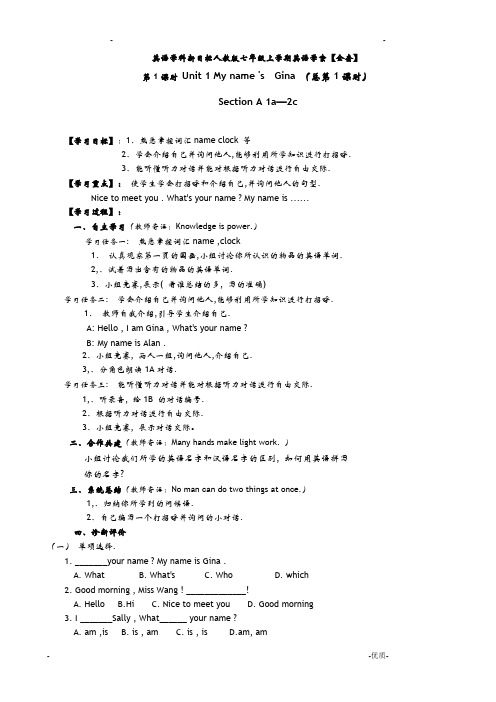
英语学科新目标人教版七年级上学期英语学案【全套】第1课时Unit 1 My name 's Gina (总第1课时)Section A 1a—2c【学习目标】:1、熟悉掌握词汇name clock 等2、学会介绍自己并询问他人,能够利用所学知识进行打招呼.3、能听懂听力对话并能对根据听力对话进行自由交际.【学习重点】:使学生学会打招呼和介绍自己,并询问他人的句型.Nice to meet you . What's your name ? My name is ......【学习过程】:一、自主学习(教师寄语:Knowledge is power.)学习任务一: 熟悉掌握词汇name ,clock1、认真观察第一页的图画,小组讨论你所认识的物品的英语单词.2,、试着写出含有的物品的英语单词.3、小组竞赛,展示( 看谁总结的多, 写的准确)学习任务二: 学会介绍自己并询问他人,能够利用所学知识进行打招呼.1、教师自我介绍,引导学生介绍自己.A: Hello , I am Gina , What's your name ?B: My name is Alan .2、小组竞赛, 两人一组,询问他人,介绍自己.3,、分角色朗读1A对话.学习任务三: 能听懂听力对话并能对根据听力对话进行自由交际.1,、听录音, 给1B 的对话编号.2、根据听力对话进行自由交际.3、小组竞赛, 展示对话交际。
二、合作共建(教师寄语:Many hands make light work. )小组讨论我们所学的英语名字和汉语名字的区别, 如何用英语拼写你的名字?三、系统总结(教师寄语:No man can do two things at once.)1,、归纳你所学到的问候语.2、自己编写一个打招呼并询问的小对话.四、诊断评价(一)单项选择.1. _______your name ? My name is Gina .A. WhatB. What'sC. WhoD. which2. Good morning , Miss Wang ! _____________!A. HelloB.HiC. Nice to meet youD. Good morning3. I _______Sally , What______ your name ?A. am ,isB. is , amC. is , isD.am, am4. ______name is Li lei .A. IB. I amC. MyD. you5.—_______, What's your name ?—John Green .A. HiB. OkC. sorryD. Excuse me(二)写出下列单词的完全形式, 并写出汉语意思.I'm _________ __________ what's __________ ________name 's ___________ __________(三)写出下列单词.时钟_______ 我的________ 你的___________ 名字_______ 遇见_________ (四)尝试翻译下列句子.1. 见到你很高兴. _________________________________.2.我叫王小雨. ____________________________________.3. 你叫什么名字? ____________________________________(五)根据情景补全对话.A: Good afternoon !B: ____________________!A; I ______Lucy . _________your name ?B: My ______ is Jim . Nice to ______you !A: _______________________________.五、【课后反思】(教师寄语:Never do things by halves)第2课时Unit 1 My name 's Gina.(总第2课时)Section A (1a—2c)【学习目标】:1、熟练掌握本课6个单词.2、学会询问他人及介绍他人.3、能听懂有关谈论他人的对话并进行自由交际.【学习重点】:询问他人及介绍他人的句型.一、自主学习(教师寄语:Knowledge is power.)学习任务一: 熟练读写本课6个单词.1.个人自渎,记忆本课单词.2.小组互相检查单词读写情况.3.根据汉语写出下列英语单词并展示.学习任务二: 运用句型:What's his / her name?His / Her name is .... 进行自由交际.1.小组合作,理解并熟读下列短语,并写出汉语意思.my nane ( ) your name ( )his name ( ) her name ( )2.个人理解下列对话,并且两人合作练习.A:Hello! What's your name?B:My name is Gina.A:Nice to meet you.B:Nice to meet you,too.A:What's her name?B:Her name is Jenny.3.小组合作,练习自己的对话.4. 对抗组开展竞赛,展示自己的对话.学习任务三: 听听力完成2a,2b.1.个人看图,理解四幅图画,思考图画中人是在谈论他人还是对方.2.听听力,给四幅图画编号.3. 小组为单位,熟读2b中的名字。
七年级英语上册学案及教学设计全集(新北师大版18份)

七年级英语上册学案及教学设计全集(新北师大版18份)鏁欏鍩烘湰淇℃伅璇鹃Unit 1 Family Lesson 1 Photos of us (First Period) 瀛︾鑻辫骞寸骇鍒濅竴鏁欏鏉愭枡鍖楀笀澶х増銆婂垵涓嫳璇€嬩竷骞寸骇锛堜笂锛?濮撳悕鍗曚綅鏁欏璁捐鎸囧鏁欏笀鎸囧鎬濇兂鏍规嵁銆婅嫳璇绋嬫爣鍑嗐€嬶紙2011骞寸増锛夌殑鍒嗙骇鏍囧噯锛屽垵涓€瀛︾敓搴旇揪鍒颁笁绾ф爣鍑嗭細瀵硅嫳璇涔犺〃鐜板嚭绉瀬鎬у拰鍒濇鐨勮嚜淇″績锛涜兘灏辩啛鎮夌殑璇濋杩涜绠€鍗曠殑浜ゆ祦锛涜兘鍒╃敤鎵€缁欐彁绀虹畝鍗曟弿杩颁竴浠朵簨鎯咃紱鑳借鎳傜畝鍗曠殑鏁呬簨鍜岀煭鏂囷紱鑳芥剰璇嗗埌璇█浜ら檯涓瓨鍦ㄦ枃鍖栧樊寮傘€?鏁欐潗鍒嗘瀽鏈鏄寳甯堝ぇ鐗堛€婂垵涓嫳璇€嬩竷骞寸骇涓婂唽鏁欐潗绗竴鍗曞厓Unit 1 Family锛岃瘽棰樹负瀹跺涵鍜屽搴垚鍛樸€傛暀甯堟牴鎹暀鏉愬唴瀹瑰拰瀛︾敓璁ょ煡姘村钩锛屽皢绗竴鍗曞厓鐨勭涓€璇綥esson 1鍒嗕负涓や釜璇炬椂銆傜涓€璇炬椂鐨勫唴瀹瑰寘鎷搴垚鍛?鐨勫叧绯诲拰绉拌皳锛岄€氳繃涓嫳鏂囧悕瀛楃殑涓嶅悓鏉ヤ綋浼氭枃鍖栧樊寮傦紝鐒跺悗鍒╃敤闃呰鑾峰彇瀹跺涵鎴愬憳鐨勫叿浣撲俊鎭紝鏈€鍚庣粨鍚堣鏂囦俊鎭拰璇█杩涜杈撳嚭娲诲姩銆傜浜岃鏃跺垯浠ヤ汉绉颁唬璇嶅拰鐗╀富浠h瘝涓轰富銆?鐢变簬鍦℅et Ready C涓凡缁忕粰瀛︾敓杩涜浜嗗叧浜庡搴垚鍛樿瘝姹囩殑瀛︿範鍜屾嫇灞曪紝鍥犳锛屽湪鏈妭璇句腑锛屾湁鍏冲搴垚鍛樼殑璇嶆眹鍙粍缁囧鐢熻繘琛岀畝鍗曠殑澶嶄範鍜屽啀鐜帮紝娌℃湁浣滀负鏈妭璇剧殑閲嶇偣瀛︿範鍐呭銆?瀛︽儏鍒嗘瀽瀛︾敓鍦ㄥ皬瀛﹂樁娈靛杩囩浉鍏宠瘽棰樼殑璇嶆眹鍜岀畝鍗曡〃杈撅紝鏈変竴瀹氱殑鍩虹锛屽苟涓斾箣鍓嶅湪Get Ready C閮ㄥ垎宸茬粡瀛︿範鍜屾嫇灞曚簡鐩稿叧璇嶆眹锛屼负瀛︾敓鍑忓皯浜嗗涔犳湰鑺傝鍐呭鐨勯殰纰嶃€傚鐢熺殑妯′豢鑳藉姏杈冨ソ锛岃鍫備笂鍏呭垎鍙戞尌绀鸿寖浣滅敤锛屽鐢熷鏁欏笀鐨勬寚浠ゅ拰瑕佹眰涓€鐩簡鐒躲€?鐢变簬瀛︾敓绗斿ご钀藉疄鐨勮兘鍔涜緝寮憋紝鏈妭璇惧湪璇村拰璇荤殑鍩虹涓婏紝涔熺粰瀛︾敓鎻愪緵浜嗗厖鍒嗙殑绗斿ご钀藉疄鐨勬満浼氾紝鍦ㄨ瑷€杈撳叆鍜岃緭鍑洪儴鍒嗗潎璁剧疆鐩稿叧鐨勭瑪澶磋惤瀹炰换鍔★紝灏嗗涔犲唴瀹瑰強鏃惰惤瀹炲苟鍙嶉鍦ㄥ妗堜笂銆傚湪闃呰涓紩瀵煎鐢熼€愭褰㈡垚闃呰绛栫暐鎰忚瘑锛屾湁鍒╀簬瀛︾敓鐨勫彲鎸佺画鍙戝睍銆?姝ゅ锛屽鐢熷鑻辫瀛︿範鏈夌潃杈冮珮鐨勭儹鎯咃紝鍠滄鍙備笌璇惧爞娲诲姩锛屽洜姝わ紝鏁?甯堢粨鍚堟湰鑺傝鐨勭洰鏍囧拰瀛︿範鍐呭璁╁鐢熸瘡涓や釜浜轰竴缁勶紝鏃㈣兘缁欏鐢熸彁渚涗簰鐩镐氦娴佸拰甯姪鐨勬満浼氾紝鍙堣兘鎺у埗娲诲姩鐨勭З搴忓拰鏁堟灉銆?鏁欏鐩爣Students will b e able to: 1. understand the cultural difference between English and Chinese names; 2. get the information of family members according to the key words; 3. tell the relationships between different family members; 4. describe someone in class using the expressions in the passage.鏁欏閲嶇偣鍜岄毦鐐?鏁欏閲嶇偣锛?1. Understand the cultural difference between English and Chinese names; 2. Get the information of family members according to the key words; 鏁欏闅剧偣锛?1. Describe someone in class using the expressions in the passage.鏁欏璧勬簮Multi-media.鏁欏鏂规硶Task-based approach (PWP), communicative approach鏉夸功璁捐Unit 1 Family Lesson 1 Photos of Us1. key words鈥時eading skill Mr/Mrs + family name2. 鎻忚堪鏌愪竴涓汉锛?浜哄悕+鈥檚琛ㄧず鏌愪汉鐨?鈥?has 鈥?鈥?lives 鈥?鈥?is 鈥?鈥?the same age as 鈥?鈥?years old 鈥?鈥?likes 鈥?鈥?wants to 鈥?璇鹃Unit 1 Family Lesson 1 Photos of Us 鏁欏杩囩▼鏁欏姝ラ鏁欏笀娲诲姩瀛︾敓娲诲姩璁捐鎰忓浘鏃堕棿Step 1 Warm up 1. Ask some questions: 1) How many members are there in your family? 2) Who are they? 3) What other family members do you know? 2. Lead Ss to do a brainstorm. Answer the questions: There are 鈥?people in my family. They are 鈥?Do the brainstorm and report in class. To recall the words of family members. 2鈥?Step2 Pre-reading 1. Show Mr Brown鈥檚family tree, then, ask Ss to find out family names and given names. 2. Let Ss use Mr or Mrs to say hello to Tom Brown鈥檚family members. 3. Ask Ss: 鈥淲hat鈥檚the relationship between Tom and Mary?鈥?4. Have Ss speak in pairs to do exercise 1 on Page 26 and choose some pairs to act out in class. 5. Let Ss read all the sentences together. Find out family names and given names.Say hello to Brown鈥檚family members with Mr or Mrs. Answer: Tom is Mary鈥檚husband. Mary is Tom鈥檚wife. Practice speaking in pairs and act out.Read aloud together. To know cultural difference.To know the relationship between family members. 10鈥?Step 3 While- reading 1. Show the first paragraph on the PPT and let Ss read aloud to gether. 2. Ask Ss to tell which family member the first paragraph describes and find out the key words. 3. Have Ss find out correct family members for the other three paragraphs and underline the key words. 4. Let Ss check the answers and key words in pairs, and then report in class. 5. Show Ss an information form and lead Ss to do the first one together as an example: Family members Information Tom & Mary They have two______ and a grandson. They live ________. 6. Tell Ss they can depend on both the passage and the family tree. 7. Ask Ss to check in pairs. Look at PPT and read aloud together.Say out: Mary Brown. Tell the key words.Read and find out the family members, at the same time underline the key words.Check the answers and key words in pairs and report in class. Read the teacher鈥檚example and complete the form on their learning sheet.Check in pairs. To get information of family members and find out the key words. 15鈥?Step 4 Post-reading 1. Give Ss an example of report: Let me tell you something about Tom and Mary. They have two granddaughters and a grandson. They live near their son. 2. Let Ss practice in pairs and report like this: Let me tell you something about 鈥?3. Have Ss read aloud the descriptions together. 4. Ask Ss how to describe someone and list the key words on the blackboard: 鈥?has 鈥?鈥?lives 鈥?鈥?is 鈥?鈥?the same age as 鈥?鈥?years old 鈥?鈥?likes 鈥?鈥?wants to 鈥?5. Have Ss work in pairs and write some information of someone in the class, give Ss an example: 鈥淟et me tell you something about my friend. She has short hair. She lives far from our school. She likes English very much. She wants to become your friend. She is thirty years old.鈥?6. Choose some pairs to give some information and let others guess who he/she is. Read the example sentences together.Practise reporting in pairs: Let me tell you something about鈥?Read aloud the descriptions together. Get the expressions from the passage and take notes. Guess the teacher鈥檚example and then write some information of someone in the class in pairs.Both members in pairs report something and let others guess. To describe someone with the key information 15鈥?Step 5 Summary & self-assessment 1. Ask Ss to think of the key points in this lesson and mark on blackboard. 2. Have Ss complete the self-assessment. Summarize and take notes.Complete the self-as sessment. To summar y and know how well Ss did. 3鈥?Unit 1 Family Lesson 1 Photos of Us (Ss鈥?learning sheet) 1. While-reading: Read again and complete the form. Family members Information Tom & Mary They have two_______________ and a grandson. They live ________________________. Lisa & John They have a son and a __________. They live near ____________ _________.Kathy & Mike They are ___________. They ________ a daughter Betty. Anna She________ a brother Mark and a __________ Betty. She is_______________________ as Betty. Mark He _______ a sister Anna. He is__________ years old. Betty She is ______________________ as Anna. She _______ a dog, Sam. She _____________ write, sing and dance. She doesn鈥檛_____________ to be a doctor.2. Post-reading: 1) Give a report according to the information form above. Let me tell y ou something about 鈥?2) How to describe someone_____________________________________________________________________ ______________________________________________________________________ ______________________________________________________________________ ______________________________________________________________________ _3) Work in pairs and write some information of someone in your class. Someone in my class Information3. Self-assessment 1) 鎴戠煡閬撹嫳鏂囧悕瀛椾腑鐨勪笉鍚屼箣澶?鏄枴鍚︹枴2) 鎴戠煡閬撳浣曚娇鐢∕r鍜孧rs 鏄枴鍚︹枴3) 鎴戣兘璇村嚭Brow n涓€瀹剁殑瀹跺涵鎴愬憳涔嬮棿鐨勫叧绯伙紝鑷冲皯涓変釜鏄枴鍚︹枴4) 鎴戣兘鍒╃敤鍏抽敭璇嶈幏寰楁湁鍏冲搴垚鍛樼殑淇℃伅鏄枴鍚︹枴5) 鎴戣兘鐢ㄨ嚦灏戜笁涓畝鍗曞彞鎻忚堪涓€涓悓瀛︽垨鏈嬪弸鏄枴鍚︹枴鎴戠殑璇勪环缁撴灉鏄細Excellent! (4-5)鈻?Not bad! (2-3)鈻?I need to work harder! (0-1)鈻?。
青岛版七年级上英语 全册教案学案

青岛版七年级上英语全册教案学案第一课教案学案教学目标- 研究并掌握新词汇和短语:英语、中国、法国、俄罗斯、坐、飞、唱、跳、游泳- 研究并能正确朗读对话和文章- 研究并能正确使用日常用语和句子结构- 能够描述人物和活动教学重点- 研究并掌握新词汇和短语- 能够正确朗读对话和文章- 能够正确使用日常用语和句子结构教学难点- 能够描述人物和活动- 能够使用所学词汇进行简单对话教学准备- 教材:青岛版七年级上英语- 多媒体设备教学步骤1. 观看课程引入视频,激发学生研究兴趣。
2. 向学生介绍新词汇和短语,帮助他们理解词义和正确发音。
3. 教师朗读对话和文章,帮助学生理解并模仿发音。
4. 分组活动:学生分组,使用所学词汇进行日常对话练。
5. 教师引导学生描述人物和活动的练,帮助他们提高口语表达能力。
6. 使用多媒体设备展示相关图片,帮助学生加深理解并拓展词汇运用。
7. 小结复,让学生总结和回顾本课所学内容。
课后作业1. 默写本课所学新词汇和短语。
2. 阅读课本上的对话和文章,并回答相关问题。
3. 翻译下列句子:我喜欢唱歌和跳舞。
第一课学案研究目标- 研究并掌握新词汇和短语:英语、中国、法国、俄罗斯、坐、飞、唱、跳、游泳- 朗读对话和文章- 使用日常用语和句子结构- 描述人物和活动研究重点- 新词汇和短语的研究和掌握- 对话和文章的朗读- 日常用语和句子结构的使用研究难点- 描述人物和活动- 使用所学词汇进行简单对话研究内容1. 研究新词汇和短语:英语、中国、法国、俄罗斯、坐、飞、唱、跳、游泳。
2. 听、读并模仿对话和文章。
3. 研究和运用日常用语和句子结构。
4. 练描述人物和活动。
5. 参与分组活动进行日常对话练。
研究过程1. 听老师介绍新词汇和短语,并理解其意义和发音。
2. 听老师朗读对话和文章,模仿发音和语调。
3. 分组活动:使用所学词汇进行日常对话练。
4. 练描述人物和活动,注意运用所学词汇。
5. 听老师引导并展示相关图片,加深理解并拓展词汇运用。
人教版七年级英语下册第十单元教案

UNIT 10 I’d like some noodles.Section A 第1课时(1a〜1c)自主学习方案1.自学生词,并记住拼读及拼写。
2.预习课本找出重点短语及句子。
(见学案自学导练内容)3.读记后完成自学导练内容。
课堂导学方案Step1 情景导入Everyone has his own taste. So what kind of food do you like?What’s your favorite food?Do you like noodles?What kind of noodles do you like?Today we'l talk about the kinds of noodles.环节说明:就学生感兴趣的身边的话题导入新课,简洁明了,引人入胜。
Step 2完成教材1a—1c的任务1.学生认真观察1a图片中的食物,然后将词语与图片搭配,集体核对答案。
(2分钟)2,老师领读单词,并纠正发音。
(2分钟)3.学生认真听录音,标出顾客所点的面条,集体核对答案,完成课本上1b的听力任务。
(3分钟)4.两人一组练习1a中的对话,然后编新对话进行练习,并请一些学生表演出他们的对话。
(5分钟)参考案例:A:What would you like?B: I,m not sure yet. Are there any vegetables in the mutton noodles?A: Yes,there are some cabbages.B: OK,I’d like the mutton noodles.5.小结训练。
(2分钟)(1)一Would you like some beef?— C .A. Yes,I wouldB. No,I wouldn’tC.Yes, pleaseD. Thanks(2)There are B hamburgers in our restrant. Would you like ?A.some;someB. some;anyC.any; anyD. any;some环节说明:听说结合,第一时间向学生传达语言目标,通过结对对话练习和小结训练,使语言目标得以强化。
天梯学案七年级下册英语鲁教版 电子版
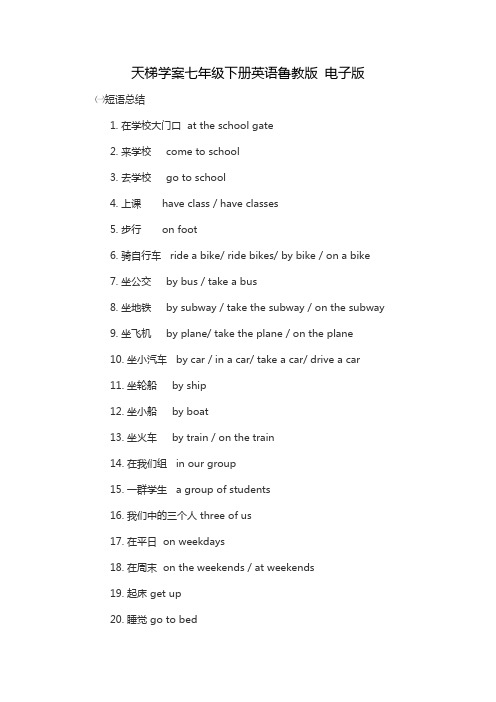
天梯学案七年级下册英语鲁教版电子版㈠短语总结1. 在学校大门口 at the school gate2. 来学校 come to school3. 去学校 go to school4. 上课 have class / have classes5. 步行 on foot6. 骑自行车 ride a bike/ ride bikes/ by bike / on a bike7. 坐公交 by bus / take a bus8. 坐地铁 by subway / take the subway / on the subway9. 坐飞机 by plane/ take the plane / on the plane10. 坐小汽车 by car / in a car/ take a car/ drive a car11. 坐轮船 by ship12. 坐小船 by boat13. 坐火车 by train / on the train14. 在我们组 in our group15. 一群学生 a group of students16. 我们中的三个人 three of us17. 在平日 on weekdays18. 在周末 on the weekends / at weekends19. 起床 get up20. 睡觉 go to bed21. 早起 get up early22. 回家 go home23. 到家 get home24. 去动物园 go to the zoo25. 去公园 go to the park26. 看电影 see a movie / film27. 看电视 watch TV28. 在晚上 in the evening / at night29. 帮助父母 help parents30. 做某人的家庭作业 do one’s ( my/ her/ his/ your/ their)homework31. 在学校 at school32. 知道,了解 know about / learn about33. 校园生活 school life34. 一个美国学生 an American student35. 在美国 in America / in the U.S.A.36. 许多学生 many students/ a lot of students/ lots of students37. 很少 very few38. 吃午饭 have lunch39. 出去吃饭 eat out40. 在校期间 on school days41. 休息一会 have a short rest/ break43. 在某人的业余时间in one’s ( my/ his/ her/ their…)free/ spare time44. 打篮球 play basketball45. 踢足球play soccer / football46. 弹钢琴 play the piano47. 弹吉他play the guitar48. 拉二胡 play erhu49. 去游泳 go swimming / go for a swim50. 去划船 go boating51. 球赛 a ball game / ball games52. 一年四次 four times a year53. 听音乐 listen to music54. 读书 read books55. 看报 read newspapers56. 看医生 see a doctor57. 去图书馆 go to the library58. 一周两次 twice a week59. 见朋友 meet friends60. 每天 every day61. 在七点半 at half past seven62. 一小会 for a little while / for a short time64. 吃饭 have dinner65. 吃早饭 have breakfast㈡重要句型同义句: I usually take the subway to school.对划线部分提问: How do you usually come to school?类似的有:go to school by bike=go to schoolon a bike= ride a bike to school=ride to schoolgo home by bus=go home on a bus=take a bus home2. How do you usually/ often…?你通常/经常怎样…?3. It’s time for class.=It’s time to have class. =It’s time for ha ving class.4. What about you? =How about you?5. How often …? 询问频率,回答可以用频率副词:always, usually, often, sometimes, seldom, never, every day ,every +其他时间名词或表示频率的短语回答表示频率的短语:次数+单位时间e.g. : once a day / twice a week / three times a month6. The early bird catches the work. (谚语) 笨鸟先飞7. Work / Study must come first. 工作/ 学习必须放在第一位!8. Classes begin at eight. =Class begins at eight.提问: What time does the class begin? / What time do the classes begin?㈢重要单词的用法1. look (感官动词) 看起来,后面加形容词His mother looks very young.They look very cute.Her dress looks very nice.You look very cool in this coat.2. by 介词by 后面直接加表示交通工具的名词,中间不用任何词修饰,如:by bike by +动词ing形式,表示通过某种方式People show love to their mothers by giving cards.You can be a good student by working hard.3. over (形容词)School / Class is over.4. begin现在分词: beginning 过去式: beganbegin to do sth , begin doing sthHe begins to write a letter. =He begins writing a letter.如果begin本身为分词,只能用begin to do sthHe is beginning to run.5. listen to 听(动作), hear 听见(结果)6. always 反义词 never7. 本话题涉及的时态为一般现在时,句中常有频率副词或表示频率的短语,如果主语为三单,动词一定要用三单!。
【人教版】2017-2018学年七年级英语上册:全一册学案(含答案)
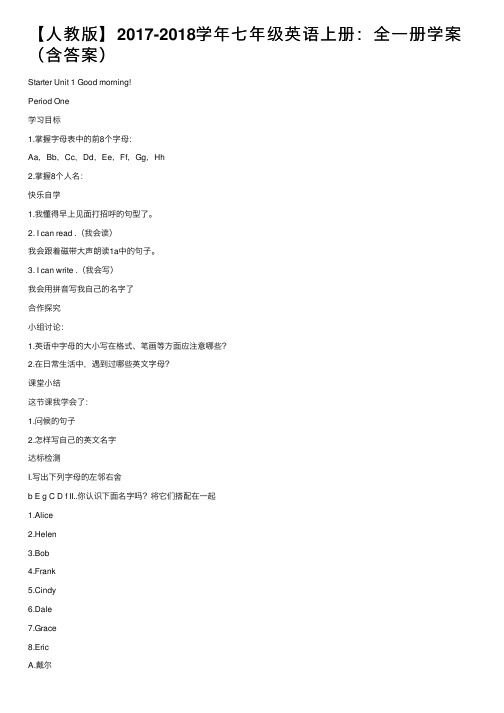
【⼈教版】2017-2018学年七年级英语上册:全⼀册学案(含答案)Starter Unit 1 Good morning!Period One学习⽬标1.掌握字母表中的前8个字母:Aa,Bb,Cc,Dd,Ee,Ff,Gg,Hh2.掌握8个⼈名:快乐⾃学1.我懂得早上见⾯打招呼的句型了。
2. I can read .(我会读)我会跟着磁带⼤声朗读1a中的句⼦。
3. I can write .(我会写)我会⽤拼⾳写我⾃⼰的名字了合作探究⼩组讨论:1.英语中字母的⼤⼩写在格式、笔画等⽅⾯应注意哪些?2.在⽇常⽣活中,遇到过哪些英⽂字母?课堂⼩结这节课我学会了:1.问候的句⼦2.怎样写⾃⼰的英⽂名字达标检测I.写出下列字母的左邻右舍b E g C D f II..你认识下⾯名字吗?将它们搭配在⼀起1.Alice2.Helen3.Bob4.Frank5.Cindy6.Dale7.GraceB.艾丽斯C.海伦D.⾟迪E.弗兰克F.埃⾥克G.格雷丝H.鲍勃III.从II栏中找出与I栏相应的答句I II( )1.Good morning! A.Good evening! ( )2.Hi, Ann! B.Good morning!( )3.Good afternoon! C.Hi, Tom! ( )4.Good evening! D.Good afternoon! IV.补全对话1.-________________, Helen!-Good morning, Cindy!2.-Hi, Bob.-________________, Alice.3.-Good evening!-_______________!V.单项选择( )1.早上或上午见⾯说:“_______”A.Good morning!B.Good afternoon!C.Good evening!( )2.熟⼈之间打招呼时应说:“_______”A.Hi!B.Good morning!C.Good afternoon!( )3.傍晚遇见你的好朋友说:“_______”A.Good morning!B.Hi!C.Good evening!B.Good morning, Eric!C.Good evening, Eric! 学习反思答案:I. a b c D E F f g h B C D C D E e f gII.1-8. BCHEDAGFIII.1-4.BCDAIV.1. Good morning2.Hello/Hi3. Good eveningV.1-4.AACAStarter Unit 1 Good morning!Period Two学习⽬标1.掌握字母表中的前8个字母:Aa ,Bb ,Cc ,Dd ,Ee ,Ff ,Gg ,Hh2.掌握3个新单词:HB ,CD ,BBC快乐⾃学1. I can listen .(我会听)我会听录⾳并跟读2a2. I can finish .(我会完成)我能根据2b 听录⾳,根据所听到的顺序为字母编号。
最新人教版(新目标)七年级上册英语同步学案:Unit 10
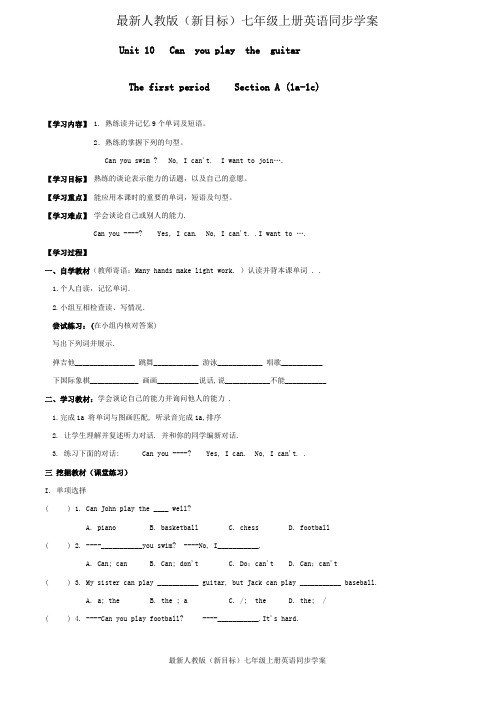
Unit 10 Can you play the guitarThe first period Section A (1a-1c)【学习内容】 1. 熟练读并记忆9个单词及短语。
2.熟练的掌握下列的句型。
Can you swim ? No, I can't. I want to join….【学习目标】熟练的谈论表示能力的话题,以及自己的意愿。
【学习重点】能应用本课时的重要的单词,短语及句型。
【学习难点】学会谈论自己或别人的能力.Can you ----? Yes, I can. No, I can't. .I want to ….【学习过程】一、自学教材(教师寄语:Many hands make light work. )认读并背本课单词..1.个人自读,记忆单词.2.小组互相检查读、写情况.尝试练习:(在小组内核对答案)写出下列词并展示.弹吉他________________ 跳舞____________ 游泳____________ 唱歌___________下国际象棋_____________ 画画___________说话,说____________不能___________二、学习教材:学会谈论自己的能力并询问他人的能力 .1.完成1a 将单词与图画匹配, 听录音完成1a,排序2. 让学生理解并复述听力对话. 并和你的同学编新对话.3. 练习下面的对话: Can you ----? Yes, I can. No, I can't. .三挖掘教材(课堂练习)I. 单项选择( ) 1. Can John play the ____ well?A. pianoB. basketballC. chessD. football( ) 2. --------;can't D. Can;( ) 3. My sister can play ___________ guitar, but Jack can play ___________ baseball.A. a; the the( ) 4. ---- ----A. Yes, I canB. No, I c( ) 5. Can he play___________ ping-A./II. 从B中找出A相应的答语A B( ) 1. Can you play chess ? A. I want to join the swimming club.( ) 2 Can he play the piano? B. Yes, I can .( ) 3 Can she draw? C . No, he can’t( ) 4 What club do you want to join? D. Yes, I do .( ) 5 Do you want to join the music club? E .Yes, she can.四、反思小结(翻译以下短语和单词,并讨论有什么不同?)1. play the guitar,play the violin,play the piano等与play basketball ,play chess,play football2. speak,say,talk五、再次尝试(课后作业)I. A.根据汉语意思或首字母,补全单词。
七年级下册英语金牌学案

七年级下册英语金牌学案一、重点语法。
1. 一般现在时。
- 概念:表示经常或习惯性的动作或状态,也可表示客观事实或真理。
- 结构:- 主语是第三人称单数(he/she/it等)时,动词要用第三人称单数形式(一般在动词原形后加 -s或 -es)。
例如:He likes reading books.- 主语不是第三人称单数时,动词用原形。
例如:I play football every day.- 时间状语:often, usually, always, sometimes, every day/week/month 等。
2. 现在进行时。
- 概念:表示现在正在进行的动作或存在的状态。
- 结构:be动词(am/is/are)+动词的 -ing形式。
例如:She is singing in the room.- 时间状语:now, at the moment等。
3. 名词的复数形式。
- 一般情况在词尾加 -s,如book - books。
- 以s, x, ch, sh结尾的名词加 -es,如box - boxes。
- 以辅音字母 + y结尾的名词,把y变为i再加 -es,如baby - babies。
- 以o结尾的名词,有生命的加 -es(如tomato - tomatoes),无生命的加 -s (如photo - photos)。
- 以f或fe结尾的名词,把f或fe变为v再加 -es,如knife - knives。
4. 形容词性物主代词和名词性物主代词。
- 形容词性物主代词:my, your, his, her, its, our, their,用来修饰名词,表示所属关系。
例如:This is my book.- 名词性物主代词:mine, yours, his, hers, its, ours, theirs,相当于“形容词性物主代词+名词”。
例如:The book is mine.二、重点词汇。
外研版英语七年级上册Module 10 computers教学案附达标巩固练习

Module 10 computersUnit 1 How do I write my homework on the computer? 教学设计一、教学目标(一)语言知识目标1.功能:描述使用电脑完成作业的过程。
2.语法:一般现在时的特殊疑问句。
3.词汇:能够正确使用一系列电脑及其使用方法的相关词汇。
(二)语言技能目标1.听:能够听懂有关电脑操作过程的指示。
2.说:能就电脑的使用步骤进行简单的问答。
3.演示与表达:能够简单表述电脑的使用方法。
二、教学过程Step 1 Warming-upShow some pictures to get students know the differences between exercise books in the past and exercise books now.Show some pictures to get students know how teachers usually check their homework.Step2.In putShow a picture of a computer to teach the new words: monitor, mouse,Keyboard, printer, flobby disk, hard ,disk, memory, mainboard, laptopListen to the tape and number the words as you hear them. Then labelThe parts of the computer. Use the words then teach how to connect theComputer and switch on the computer using first, then , finally.e.g.: A:I have a new computer ,how can I connect this computer?B: Look ,first ,connect the monitor to the computerA: what can I do next?B: Then…A: …B: Finally…Step3.PracticeShow how to write your homework on the computer. Use the pictures to show the way step by step.Listen to the tape for the first time, answer the two easy questions:1. What does Lingling want to do with the computer?2. Who is good at using computers?Read the text and finish part 5.Number the instructions in the correct order.Ask students to act the dialogue out. Answer the questions:1. How do you open a new document?2. Where do you write your homework?3. How do you save the document?4. Where do you write its name?5. What do you do next?6. How do you print it?Step4.Out put(discuss)1.Do you like to write your homework on the exercise book or on the computer?2.It’s a new way of writing your homework. Do you think it’s good or not? Why?Step5.SummaryKey vabularary:Keyboard,monitor,mouse,printer,mainboard,memory,harddisk,floppydisk,laptop,document,connect,switch on,click ,save,finally.Sentence structure:How do you …?Where do you…?What do you…?Step6.FeedbackStep7.HomeworkType the text on the computer using word software; write down how you do it. Students can write like this: First…then…finally...一、达标题I补全对话:A: 1 2 , Mr John. I can’t 3 Tom. Where 4 he?B: Oh, 5 is he wearing?A: 6 is 7 a white sweater and green trousers.B: Look, he is 8 .A: Yes, let’s 9 and see him.II Ask and answer. Use usually and often.1.do your homework/on your computer?2. What games/play?3. send emails?4. who/ write to?5. use/a computer at school?6. download music?7. What kind of music/ download?III.1. Tony _________(not visit) his uncle, but he often __________(send) emails.2.We __________(use) the Internet, but we __________(not play) games on our computer.3.Daming _________(not use) a computer to do his homework, but he ______________( download) music答案:I.1. Excuse 2. me 3. find 4. Is 5. what 6. He 7. wearing 8. there 9. goII.1. Do you usually do your homeworkon your computer?2. What games do you usually play?3. Do you often send emails?4. who do you usually write to?5. Do you often use a computer at school?6. Do you usually download music?7. What kind of music do you usually download?III. 1. Doesn’t visit ,doesn’t send 2. Don’t use, Don’t play3. doesn’t use, doesn’t downloadM10U2 He decided to be an actor.教学目标:1、学会本模块动词的过去式:like marry move join become start enjoy open die see2、学会正确使用一般过去时谈论莎士比亚的简要生平,培养学生的阅读技巧。
- 1、下载文档前请自行甄别文档内容的完整性,平台不提供额外的编辑、内容补充、找答案等附加服务。
- 2、"仅部分预览"的文档,不可在线预览部分如存在完整性等问题,可反馈申请退款(可完整预览的文档不适用该条件!)。
- 3、如文档侵犯您的权益,请联系客服反馈,我们会尽快为您处理(人工客服工作时间:9:00-18:30)。
Unit 4 Topic 1Section A汉译英1.七十八2.九十二3.八百八十五4.三百零六5.二十六6.四百零一7.五十四8.七百九十九9.五百五十五选择题( )1. It looks nice ______ you .A. atB. onC. inD. to( )2. I like the dress. Can I ______ ?A. try it onB. try on itC. try them onD. try on them ( )3. 一Thanks very much . 一______A. No thanks.B. Not at all.C. You are welcome.D. B and C ( )4. He wants to ______ a present ______ his father.A. buy, forB. buy, ofC. give, forD. buy, to ( )5. Your shoes are ______ .A. over hereB. over thereC. at thereD. at here ( )6. 一______ are these shoes? 一Fifty yuan .A. How oldB. How muchC. How manyD. How ( )7. The dress is very nice and I’ll ____ it.A. thinkB. takeC. wantD. bring ( )8. Would you like ______ with me?A. goesB. goC. to goD. going完成句子1.这件外套多少钱?is this coat ?2.我要把它买下来。
I will it.3.你的课本在那边。
Your book is .4.这条短裙怎样?What this skirt?5.我想要那件黄色的外套。
I the yellow coat.【中考链接】( ) 1.If you meet some new words, you can ______ in a dictionary. (2011年清远)A. look it upB. look up itC. look them upD. look up them ( ) 2.一What is eleven and ______ ? 一It’s twenty.A. sevenB. nineC. eightD. ten( ) 3. —____ ? —I want a pair of shoes for my son.A. Can I help youB. What do you doC. What do you buyD. What do you want汉译英1.认为2. 考虑3.为什么不…4. …怎么样?5.一点也不6.试(穿)7.太长8.购物清单选择题( )1. —______ is the pencil? —One yuan .A. How oldB. How muchC. How manyD. How( )2. —What do you think______ the movie? —It’s funny.A. aboutB. ofC. onD. for( )3. —______ the coat? —It is too big.A. What do you likeB. How do youC. What do you thinkD. How do you like ( )4. Why not ______ shopping with me?A. goB. to goC. goesD. going( )5. —Sorry, I can’t help you. —Thank you ______ .A. the sameB. all the sameC. tooD. again( )6. The coat is too ______ . I want a smaller one.A. longB. shortC. bigD. small( )7. —Can I help you? —I’m ______ looking, thanks.A. justB. onlyC. just onlyD. A and B( )8. —Can I look at your photo? — ______ .A. Yes, I doB. Yes, here you areC. No, you can’tD. Yes, I am句型转换1. What can I do for you? (同义句转换) May I you?2. How do you like this book?(同义句转换) do you of this book?3. How about playing basketball? (同义句转换) play basketball?4. I want to buy this shirt. (同义句转换) I to buy this shirt .5. The dress is only 30 yuan.(对画线部分提问) is the dress?【中考链接】( ) 1. —What can I do for you? —____ .(2010广州)A. Yes, you can give a skirt to meB. I’d like a skirtC. No, I can do it myselfD. I can do what I want( ) 2. —The clothes are one hundred yuan. —One hundred yuan! ____ you ____?A. Do; kiddingB. Do; kidC. Is; kiddingD. Are; kidding ( ) 3. —____ ? —I want a pair of shoes for my son.A. Can I help youB. What do you doC. What do you buyD. What do you want( ) 4. The girl wants to buy ___ .A. a new pair of shoesB. a pair of new shoesC. new a pair of shoesD. a pair new of shoes汉译英1.买东西2.担心3.三公斤苹果4.两瓶水5.八片面包6.四杯果汁7.一双鞋8.六包盐选择题( )1. —What color are the ____ ? —It’s ____.A. orange; orangeB. orange; orangesC. oranges; orangeD. oranges; oranges ( )2. This pair of shoes ____ mine. His are over there.A. amB. isC. areD. be( )3. How ____ oranges do you have?A. manyB. muchC. someD. any( )4. —How much is the rice ? —It’s ____.A. a kilo four yuanB. four yuan a kiloC. four yuans a kiloD. a kilos of four yuan ( )5. There are many ____ in the old house.A. mouseB. mousesC. miceD. mices( )6. —How do you like the ______ ? — They are too long .A. pantB. pantsC. shoesD. cap( )7. —Can you see ______ oranges on the tree? — Yes, I can see ______ .A. an; anB. some; anyC. any; someD. some; some ( )8. Please give me some____ .A. vegetableB. saltC. breadsD. shoeⅠ完成句子。
1.他想要两包盐。
He wants two salt.2.小明很担心他的学习。
Xiao Ming his study.3.—你有一些铅笔吗?—Do you have pencils?—是的,我有一些。
—Yes, I have .4.你要多少瓶果汁?of juice do you want?5.这条蓝色的裤子怎么样?What about the blue of pants?Ⅱ单词归类。
book salt rice apple juice shoe milk bread student pen hair bottle box coat可数名词不可数名词【中考链接】( ) 1. I'm so hungry. Please give me ______ to eat . (2011年清远)A. three bread B three pieces of breadC. three pieces of breads D three piece of bread( ) 2. How much ______ is there in the bottle?A. orangeB. orangesC. applesD. pears( ) 3. Michael has ______ rulers, but I don’t have ______ .A. some; someB. some; anyC. any; someD. any; any( ) 4. —How many ____ would you like? —Two, please.A. glasses of milkB. glass of milksC. glasses of milksD. glass of milk配对( )1.Thank you very much . A. Three bottles, please.( )2.Can I help you? B. Yes, I think so.( )3.Is that all ? C. I want to buy a dress for my daughter.( )4.How do you like the pants? D. They are too long.( )5.How much water do you want? E. It’s 28 yuan.( )6.How much is the T-shirt ? F. Three.( )7.How many apples do you have?G. Yes, please. I’d like the red coat.( )8.What can I do for you, madam? H. Not at all.选择题( )1. —Dad. I’m sorry I can’t find the shop.—____A. Not at all.B. I’m not happy.C. Thank you all the same.D. You can’t come back.( )2. Twenty-two and thirty-seven is ____.A. fifty-nineB. fifty nineC. forty-nineD. fifteen( )3. —Some vegetables, a bag of rice and two kilos of eggs. Is that all ? — I think ____ .A. soB. thatC. itD. this情景交际从方框中选出适当的句子补全对话,有两项多余。
